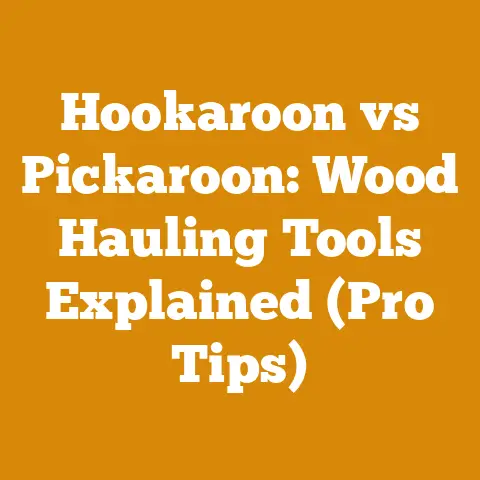Tree Root Removal Machine: Best Beginner Stump Grinders (Pro Tips)
Let’s future-proof your landscape, shall we?
We’re not just talking about getting rid of an unsightly stump; we’re talking about reclaiming your yard, preventing future problems, and maybe even turning what was once a nuisance into an opportunity.
Think of it like this: a stump is a problem, but a cleared space is a blank canvas.
And what’s the key to unlocking that potential?
A stump grinder.
The global wood processing and logging industry is a multi-billion dollar behemoth, projected to reach staggering heights in the coming years.
Within that, the niche of land clearing and stump removal is also experiencing significant growth, driven by urbanization, infrastructure development, and an increased focus on landscape aesthetics.
Firewood, while seemingly simple, is also a key component.
Did you know that in some regions, firewood still accounts for a significant percentage of household heating?
It’s a blend of tradition and necessity, and efficient wood processing is paramount.
Understanding the World of Stump Grinders
Before we dive into specific models, let’s establish a solid foundation.
What exactly is a stump grinder, and why is it the best tool for the job?
What is a Stump Grinder?
Simply put, a stump grinder is a power tool designed to remove tree stumps by grinding them into small chips.
Unlike manual removal methods, which can be back-breaking and time-consuming, a stump grinder utilizes a high-speed rotating cutting wheel with hardened teeth to efficiently chew through the wood.
Why Use a Stump Grinder?
- Efficiency: Stump grinders can remove stumps in a fraction of the time it would take using manual methods like digging and chopping.
- Effectiveness: They can grind stumps below ground level, allowing you to replant grass or install landscaping without any remaining obstructions.
- Safety: While safety precautions are crucial (more on that later), stump grinders are generally safer than using axes or chainsaws to remove large stumps.
- Cost-Effective: While there’s an initial investment (or rental cost), stump grinders can save you money in the long run by eliminating the need to hire professional stump removal services.
- Aesthetics: Let’s be honest, a stump is an eyesore.
Removing it dramatically improves the appearance of your property.
Types of Stump Grinders
Stump grinders come in various shapes and sizes, each suited for different applications.
Here’s a breakdown:
- Hand-Guided Stump Grinders: These are the most common type for homeowners and smaller jobs.
They are maneuvered manually and offer a good balance of power and portability.
These are what we’ll focus on as the best beginner options. - Tow-Behind Stump Grinders: These larger, more powerful machines are towed behind a vehicle and are suitable for larger stumps and commercial applications.
- Self-Propelled Stump Grinders: These grinders have their own engine and drive system, making them easier to maneuver on uneven terrain.
They are a step up from hand-guided models in terms of power and convenience. - Hydraulic Stump Grinders: These heavy-duty machines use hydraulic power to drive the cutting wheel and are designed for the toughest stumps.
They are typically used by professional landscaping companies. - Stump Grinder Attachments: Some manufacturers offer stump grinder attachments for skid steers or excavators, allowing you to convert existing equipment into a stump grinder.
For beginners, a hand-guided stump grinder is the most practical and affordable option.
They are relatively easy to operate, and powerful enough to handle most residential stumps.
Choosing the Right Stump Grinder for Beginners
Now that you understand the basics, let’s talk about selecting the right stump grinder for your needs.
Consider these factors:
Stump Size
The size of the stumps you plan to remove is a crucial factor in determining the appropriate stump grinder.
Smaller, hand-guided models are typically suitable for stumps up to 12 inches in diameter.
For larger stumps, you may need a more powerful tow-behind or self-propelled model.
Engine Power
Engine power is measured in horsepower (HP).
A higher HP rating generally translates to more cutting power.
For beginner-friendly hand-guided models, look for engines in the 13-20 HP range.
This will provide sufficient power for most residential stumps.
Cutting Depth
The cutting depth refers to how far below ground level the grinder can remove the stump.
A deeper cutting depth allows you to completely eliminate the stump and root ball, preventing regrowth and allowing for seamless landscaping.
Aim for a cutting depth of at least 6-12 inches below ground level.
Wheel Size and Teeth
The size and number of teeth on the cutting wheel also affect the grinder’s performance.
Larger wheels with more teeth generally cut faster and more efficiently.
Look for wheels with carbide-tipped teeth, which are more durable and resistant to wear.
Portability and Maneuverability
Consider the weight and size of the stump grinder, especially if you need to transport it or maneuver it in tight spaces.
Hand-guided models are generally more portable than tow-behind or self-propelled models.
Safety Features
Safety should always be a top priority when operating power equipment.
Look for stump grinders with safety features such as:
- Emergency shut-off switch: Allows you to quickly stop the engine in case of an emergency.
- Wheel guards: Protect you from flying debris.
- Operator presence control: Stops the engine if you release the handles.
Budget
Stump grinders range in price from a few hundred dollars to several thousand dollars.
Set a budget before you start shopping and stick to it.
Consider the long-term cost of ownership, including maintenance and repairs.
Renting a stump grinder is also a viable option if you only need it for occasional use.
My Personal Recommendations for Beginner-Friendly Stump Grinders
Based on my experience and research, here are a few stump grinders that I would recommend for beginners:
- DK2 Power 14HP Gas Powered Stump Grinder: This is a great all-around option that offers a good balance of power, portability, and affordability.
It features a 14 HP engine, a 12-inch cutting wheel, and a cutting depth of up to 9 inches below ground. - Landworks Mini Electric Wheeled Stump Grinder: An electric option, this is great for smaller jobs and those sensitive to noise.
It’s lightweight and easy to maneuver. - NorthStar Compact Stump Grinder: This is a more powerful option that can handle larger stumps.
It features a 160cc Honda engine, a 10-inch cutting wheel, and a cutting depth of up to 12 inches below ground.
Remember to read reviews and compare specifications before making a final decision.
Preparing for Stump Grinding: Safety First!
Before you even think about firing up that engine, let’s talk safety.
Stump grinding is inherently dangerous, and taking the proper precautions is essential to prevent injuries.
I’ve seen firsthand what can happen when safety is neglected, and it’s not pretty.
Essential Safety Gear
- Eye Protection: Wear safety glasses or a face shield to protect your eyes from flying debris.
- Hearing Protection: Stump grinders are loud. Wear earplugs or earmuffs to protect your hearing.
- Gloves: Wear heavy-duty work gloves to protect your hands from cuts and abrasions.
- Long Pants and Long-Sleeved Shirt: Cover your skin to protect it from flying debris.
- Steel-Toed Boots: Protect your feet from injury.
- Dust Mask: Wear a dust mask to protect your lungs from dust and wood particles.
Pre-Grinding Checklist
- Clear the Area: Remove any rocks, debris, or other obstructions from around the stump.
This will prevent them from becoming projectiles.
I once had a small rock flung with enough force to dent my truck.
Lesson learned! - Inspect the Stump: Check the stump for any metal objects, such as nails or wires.
These can damage the cutting wheel and create sparks. - Call Before You Dig: Contact your local utility companies to locate any underground utilities before you start grinding.
Hitting a gas line or electrical cable can have catastrophic consequences.
This is not optional! - Inform Neighbors: Let your neighbors know that you will be operating a loud piece of equipment.
This will help to minimize disruptions and prevent complaints. - Read the Manual: Familiarize yourself with the operating instructions for your specific stump grinder model.
Pay close attention to the safety warnings. - Check the Machine: Before each use, inspect the stump grinder for any signs of damage or wear.
Make sure all bolts are tight and that the cutting wheel is sharp.
Setting Up a Safety Zone
Establish a safety zone around the stump grinding area to keep bystanders away.
A radius of at least 50 feet is recommended.
Use caution tape or cones to mark the boundaries of the safety zone.
Never allow children or pets near the stump grinder while it is in operation.
Personal Safety Habits
- Stay Alert: Pay attention to your surroundings and be aware of potential hazards.
- Take Breaks: Stump grinding can be physically demanding. Take frequent breaks to avoid fatigue.
- Never Operate Under the Influence: Do not operate a stump grinder if you are under the influence of alcohol or drugs.
- Keep a First-Aid Kit Handy: In case of an accident, have a well-stocked first-aid kit readily available.
- Know Your Limits: If you are not comfortable operating a stump grinder, hire a professional.
Step-by-Step Guide to Stump Grinding
Okay, you’ve got your safety gear on, the area is clear, and you’ve read the manual.
Let’s get grinding!
Step 1: Starting the Engine
Follow the manufacturer’s instructions for starting the engine.
Most stump grinders have a pull-start mechanism.
Make sure the engine is properly warmed up before you start grinding.
Step 2: Positioning the Grinder
Position the stump grinder so that the cutting wheel is directly over the stump.
Adjust the height of the wheel so that it is slightly above the top of the stump.
Step 3: Engaging the Cutting Wheel
Engage the cutting wheel according to the manufacturer’s instructions.
Some models have a lever or switch that engages the wheel, while others have an automatic engagement system.
Step 4: Grinding the Stump
Slowly move the stump grinder back and forth across the stump, allowing the cutting wheel to grind away the wood.
Use a sweeping motion to ensure that you are removing the entire stump.
Avoid forcing the grinder, as this can damage the cutting wheel or the engine.
Step 5: Adjusting the Depth
As you grind down the stump, gradually lower the cutting wheel to increase the cutting depth.
Continue grinding until the stump is completely removed and the area is level with the surrounding ground.
Remember to grind below ground level!
Step 6: Removing the Chips
Use a shovel or rake to remove the wood chips from the grinding area.
You can use the chips as mulch or compost.
Step 7: Filling the Hole
Fill the hole left by the stump with topsoil or fill dirt.
Tamp down the soil to create a level surface.
Step 8: Cleanup
Clean the stump grinder thoroughly after each use.
Remove any debris from the cutting wheel and lubricate the moving parts.
Store the grinder in a dry, secure location.
Pro Tips for Efficient Grinding
- Sharp Teeth are Key: Dull teeth will make the job much harder and can damage the grinder.
Sharpen or replace the teeth regularly. - Grind in Layers: Don’t try to remove too much material at once.
Grind in thin layers to avoid bogging down the engine. - Use a Water Hose: Spraying the stump with water can help to keep the dust down and lubricate the cutting wheel.
- Watch for Obstacles: Be aware of any rocks, roots, or other obstacles that may be hidden beneath the surface.
- Take Your Time: Stump grinding is not a race.
Take your time and work carefully to avoid accidents.
Dealing with Difficult Stumps
Not all stumps are created equal.
Some are larger, harder, or located in difficult-to-reach areas.
Here are some tips for dealing with challenging stumps:
Large Stumps
For very large stumps, you may need to make multiple passes with the stump grinder.
Start by grinding around the perimeter of the stump and then work your way towards the center.
You may also need to use a larger, more powerful stump grinder.
Consider renting a tow-behind model for these situations.
Hardwood Stumps
Hardwood stumps, such as oak or maple, are more difficult to grind than softwood stumps.
Use a sharp cutting wheel and take your time.
You may also need to apply more pressure to the grinder.
Stumps in Tight Spaces
If the stump is located in a tight space, such as near a fence or building, you may need to use a smaller, more maneuverable stump grinder.
You may also need to remove some of the surrounding vegetation to create more room to work.
Stumps with Extensive Root Systems
Some stumps have extensive root systems that extend far beyond the visible stump.
In these cases, you may need to dig around the stump to expose the roots before you can grind them.
Use a shovel or pickaxe to break up the roots.
Stumps Near Utilities
If the stump is located near underground utilities, exercise extreme caution.
Contact the utility companies to locate the utilities before you start grinding.
You may need to use hand tools to remove the stump to avoid damaging the utilities.
Troubleshooting Common Problems
Even with the best preparation, things can sometimes go wrong.
Here are some common problems you may encounter and how to fix them:
- Engine Won’t Start: Check the fuel level, spark plug, and air filter.
Make sure the engine switch is in the “on” position.
If the engine still won’t start, consult the owner’s manual or take it to a qualified mechanic. - Cutting Wheel Won’t Turn: Check the belt tension and the condition of the belt.
Make sure the cutting wheel is not obstructed by debris.
If the wheel still won’t turn, consult the owner’s manual or take it to a qualified mechanic. - Grinder Overheats: Check the engine oil level and the cooling fins.
Make sure the air filter is clean.
If the grinder continues to overheat, stop using it and let it cool down before proceeding. - Cutting Wheel Gets Stuck: Stop the grinder immediately and remove any debris that is obstructing the wheel.
Avoid forcing the grinder, as this can damage the cutting wheel or the engine. - Excessive Vibration: Check the cutting wheel for damage or imbalance.
Make sure all bolts are tight.
If the vibration persists, consult the owner’s manual or take it to a qualified mechanic.
The Aftermath: Reclaiming Your Space
Congratulations! You’ve successfully removed the stump. Now what?
Filling the Hole and Leveling the Ground
As mentioned earlier, filling the hole with topsoil or fill dirt is essential.
Compact the soil to prevent settling and create a level surface.
Replanting and Landscaping
Once the area is level, you can replant grass, install landscaping, or build a patio.
The possibilities are endless!
Using the Wood Chips
The wood chips generated by the stump grinder can be used as mulch for gardens and flowerbeds.
They can also be composted to create nutrient-rich soil.
Don’t just throw them away!
Preventing Future Stumps
The best way to deal with stumps is to prevent them from forming in the first place.
When planting new trees, choose varieties that are less likely to develop extensive root systems.
Also, make sure to prune trees regularly to maintain their health and prevent them from becoming damaged or diseased.
Cost Considerations and Budgeting
Stump removal can be expensive, especially if you hire a professional.
Here’s a breakdown of the costs involved:
- Stump Grinder Rental: Rental rates typically range from \$100 to \$300 per day, depending on the size and power of the grinder.
- Stump Grinder Purchase: New stump grinders can cost anywhere from \$500 to \$5,000 or more, depending on the features and capabilities.
- Safety Gear: Safety glasses, ear protection, gloves, and other safety gear can cost around \$50 to \$100.
- Fuel and Maintenance: Fuel and maintenance costs can add up over time, especially if you use the grinder frequently.
- Disposal Fees: If you need to dispose of the wood chips, you may have to pay disposal fees.
- Labor Costs: If you hire a professional, labor costs can range from \$100 to \$500 or more, depending on the size and complexity of the job.
To save money, consider renting a stump grinder instead of buying one.
You can also save money by doing the work yourself.
However, be sure to factor in the cost of your time and effort.
Case Study: From Eyesore to Oasis
I once helped a friend remove a massive oak stump from his backyard.
The stump was over 3 feet in diameter and had been there for years.
He had tried everything to get rid of it, including digging, chopping, and even burning.
Nothing worked.
Finally, he decided to rent a stump grinder.
We spent an entire weekend grinding away at the stump, but eventually, we succeeded.
The transformation was amazing.
The backyard went from an eyesore to an oasis.
He replanted grass and installed a patio, creating a beautiful outdoor living space.
The cost of renting the stump grinder was well worth it.
Beyond Stump Grinding: Exploring Wood Processing and Firewood
The skills and knowledge you gain from stump grinding can be applied to other wood processing tasks, such as firewood preparation.
Chainsaws vs. Axes: A Timeless Debate
The age-old question: chainsaw or axe for firewood?
The answer depends on your needs and preferences.
Chainsaws are faster and more efficient for felling trees and bucking logs, but they require more maintenance and can be dangerous if not used properly.
Axes are slower and more labor-intensive, but they are simpler to use and require less maintenance.
Personally, I use both.
I use a chainsaw for the initial felling and bucking, and then I use an axe or maul to split the logs.
Some species burn hotter and longer than others. Here’s a quick guide:
- Hardwoods: Oak, maple, ash, and birch are excellent choices for firewood.
They burn hot and long, producing a lot of heat. - Softwoods: Pine, fir, and spruce are less desirable for firewood.
They burn quickly and produce less heat.
They also tend to create more smoke and creosote.
The key is to season the wood properly.
Green Wood vs. Seasoned Wood
Green wood is freshly cut wood that contains a high moisture content.
Seasoned wood is wood that has been allowed to dry for several months or years.
Seasoned wood burns much more efficiently than green wood.
The Importance of Seasoning Firewood
Seasoning firewood is essential for efficient burning.
Green wood contains up to 50% moisture, which means that a significant amount of energy is required to evaporate the water before the wood can burn.
Seasoned wood, on the other hand, contains only about 20% moisture, which means that it burns much hotter and cleaner.
How to Season Firewood
- Split the Wood: Splitting the wood increases the surface area exposed to air, which speeds up the drying process.
- Stack the Wood: Stack the wood in a single row, with the bark side up.
This will allow air to circulate around the wood. - Elevate the Wood: Elevate the wood off the ground using pallets or cinder blocks.
This will prevent moisture from wicking up from the ground. - Cover the Wood: Cover the top of the woodpile with a tarp to protect it from rain and snow.
Leave the sides open to allow air to circulate. - Wait: Allow the wood to season for at least six months, or preferably a year or more.
Data Point: Firewood Moisture Content
The ideal moisture content for firewood is between 15% and 20%.
You can use a moisture meter to measure the moisture content of your firewood.
Case Study: Optimal Firewood Stacking
I once conducted a small experiment to determine the best way to stack firewood for optimal drying.
I stacked three piles of firewood: one in a single row, one in a crisscross pattern, and one in a tightly packed pile.
After six months, I measured the moisture content of each pile.
The single-row pile had the lowest moisture content, followed by the crisscross pile.
The tightly packed pile had the highest moisture content.
This confirmed that air circulation is essential for efficient drying.
Next Steps and Additional Resources
You’ve now got a solid foundation in stump grinding and wood processing.
Here are some next steps you can take to further your knowledge and skills:
- Practice: The best way to learn is by doing.
Rent a stump grinder and start practicing on small stumps. - Take a Class: Consider taking a class on stump grinding or chainsaw safety.
- Join a Community: Join an online forum or local woodworkers’ club.
- Read Books and Articles: There are many excellent books and articles on stump grinding and wood processing.
- Watch Videos: Watch videos on YouTube or other video-sharing platforms.
Suppliers of Logging Tools and Drying Equipment
- Northern Tool + Equipment: Offers a wide selection of stump grinders, chainsaws, and other logging tools.
- Amazon: A great place to find moisture meters, safety gear, and other wood processing supplies.
- Local Rental Companies: Rent stump grinders and other equipment for short-term use.
Drying Equipment Rental Services
While you likely won’t rent “drying equipment” specifically, you can rent tarps and other materials to cover your firewood stacks.
Check with local rental companies or hardware stores.






